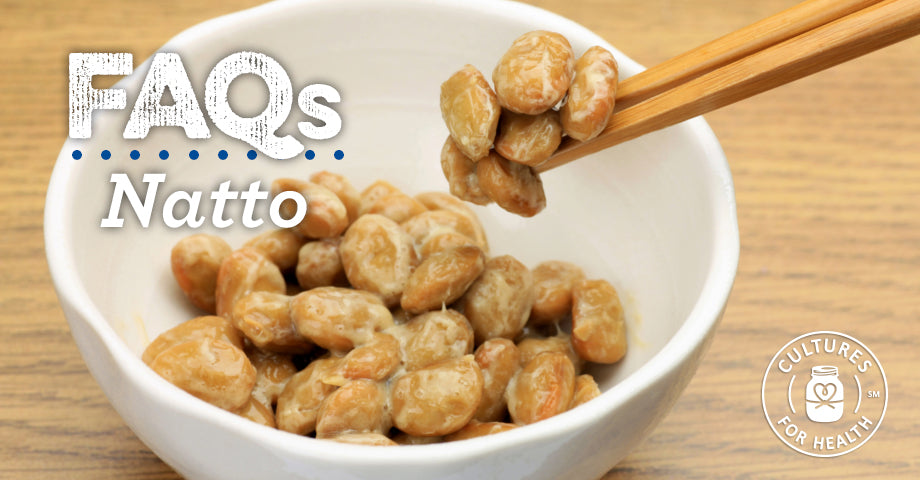
Q. What is natto?
A. Natto is a cultured bean product, most often made from soybeans. It originated in Japan and is known for its slimy, stringy texture and pungent odor. Natto is a popular breakfast food, served over rice and complemented by pickled vegetables. In today's trend toward cultural fusion, natto is used in a wide variety of foods, such as pizza, pasta, tacos, and even ice cream!
Q. What does natto taste like?
A. Despite it’s strong odor during culturing, natto does not have an overwhelming taste unless it is aged. In plain natto, most people are more aware of the texture than the taste. The strands are slimy and leave a residue easily. Natto readily takes to added flavors.
Q. What is in natto?
A. Most often, natto is made with soybeans. The beans are inoculated with Bacillus subtilus natto, also known as natto-kin in Japanese. Commercially, natto tends to have additives such as soy sauce, sugar, flavor enhancers and preservatives.
Q. What else can be made with natto?
A. While natto is traditionally made with soybeans, it can be made with other high-protein beans, such as garbanzo, black bean, adzuki, and others. To use alternative beans, follow the same procedure and make minor adjustments to preparation of the beans and culturing time.
Q. Where do I get the best soybeans?
A.While there are online sources, soybeans may also be found at local stores or through buying clubs. Natto spores work well with any kind of soybeans. Organic, non-GMO soybeans are recommended. Soybeans have a long shelf life, so it may be more practical to purchase beans in bulk.
Q. How is natto made?
A. Detalied instructions are included with your Natto Starter. Our recipe for making Natto may be found here.
Q. When is natto finished culturing?
A. If a strong odor is detected from the culturing area, and if it has been about 24 hours, carefully open natto with very clean hands. Check for small, gelatinous strands forming across the surface of the beans. Using a utensil that has been boiled, stir a section of the culture. It should form strands easily if it is done. When finished, cool and refrigerate for up to several months. An aging period of 24 hours to 3 days will yield a better flavor.
Q. What can I culture my natto in?
A. Natto can be cultured in many kinds of containers. Traditionally it was made in bundles of straw. In the early 1900’s, scientists isolated the bacteria that forms natto. This allowed it to be produced easily in any kind of container. Natto needs to culture in a shallow layer, with a lid or moist covering. Unlike tempeh, natto needs to be kept relatively moist. A dry natto cannot form strands.
Q. How do I maintain culturing temperature to make natto?
A. To maintain temperatures, use a cube dehydrator, a box or cooler with a heating pad, reptile mat or seedling mat, or a yogurt maker. If using a yogurt maker, the lid may need to be propped open to keep the temperature low enough. Many Asian specialty markets sell combination yogurt/natto makers.
Q. How can natto be consumed?
A. Natto is an extremely versatile food. Traditionally it is enjoyed atop a bowl of rice with green onions, pickled radish and a splash of soy sauce and hot sauce. However, natto is a great fermented protein and is enjoyed in many dishes. Some people serve it over pasta. It also makes a delicious taco filling.
Q. How long does it take to make natto?
A. Natto generally takes about 24 hours to culture. Plan to keep a watch on it the last few hours. In warmer temperatures, natto can culture more quickly. In cooler temperatures, or if using alternative beans, natto may need to culture longer. People who enjoy an especially pungent natto may wish to culture for 30-36 hours.
Q. How long can natto be stored?
A. Natto can be stored for several months in the refrigerator. Press a piece of cheesecloth or unbleached parchment paper over the surface to retain moisture; store in an airtight container. The longer it is stored, the more pronounced the flavor will become. Natto may also be stored in the freezer. Once thawed, natto should be consumed within one week.
Q. How long can natto starter be stored?
A. Natto can be stored
- At room temperature (68º-78ºF) for 3-4 weeks
- In the refrigerator (40º-45ºF) for 6 months or more
- In the freezer (0º-25ºF) for 6 months or more
- Maximum culturing temperature 115ºF
Q. Even though any soybean is fine, why do I hear smaller beans are better?
A. The fermentation process is much more efficient as the center of the bean is more easily reached.














